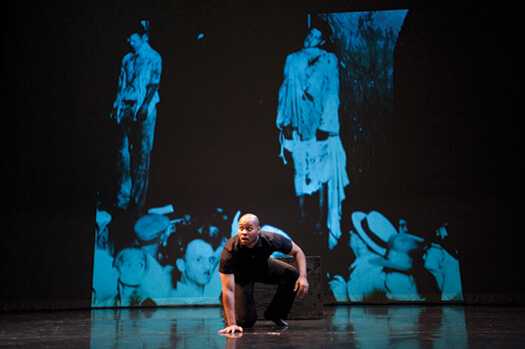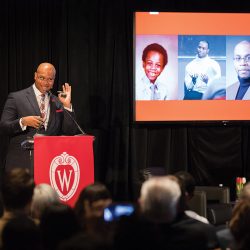How to Stage a Lynching

Fear takes center stage: In his one-man play Ten Perfect, Patrick Sims portrays a fictionalized version of James Cameron, who was nearly lynched in Marion, Indiana, in 1930. Two other men were murdered that night, and the act was captured in an iconic photo (shown in the background) that inspired the lyrics to “Strange Fruit.” Photo: Jeff Miller
Theater professor Patrick Sims preserves a chapter of history through drama.
In February, Patrick Sims stood on a box in front of a crowd of hundreds and contemplated death by hanging.
What would it feel like, the rope biting into his flesh, his throat constricting, the last sound in his ears being his name chanted by bloodthirsty onlookers?
It was important to Sims that he get this right. A lynching is something you really don’t want to botch. Not this lynching anyway — possibly the most noted extrajudicial hanging in American history, certainly the most important for his career.
The rope around Sims’s neck that night was imaginary, but he wanted to fully inhabit the man who had felt it tighten around his throat for real. He was also trying to give life to two other men who already hung from the tree, as well as the man they were accused of murdering, and many of those who wanted to see him swing. Essentially, Sims had to embody every aspect of that lynching.
That’s what a one-man drama is all about.
Sims was performing the solo show he’d written, Ten Perfect. In it, he plays eighteen different roles in seven scenes that span seventy-six years. Ten Perfect isn’t the first play Sims has written, but it’s the one that’s most important to him, for both its message and its impact — his performance came just days before his own tenure review, and members of the review committee were in the audience.
The play’s title comes from the way the main character’s mother described him at birth: “ten perfect fingers and ten perfect toes,” a state of wholeness that he has difficulty maintaining. The plot is a fictionalized account of the experience of James Cameron, who was nearly lynched in Marion, Indiana, in August 1930, but survived to devote the next seven decades, until his death, to promoting civil rights.
Cameron became a local legend in Milwaukee, where, in 1988, he founded America’s Black Holocaust Museum. Sims’s discovery of Cameron and his museum marked a turning point in his career.
“I was just shocked that I’d never heard of James Cameron until that first haphazard visit to the museum,” Sims says. “[Before, I] didn’t know anything about America’s Black Holocaust Museum, would have never known had I not decided to come to Wisconsin for graduate school. But that summer I became sort of smitten by Dr. Cameron.”
Over the course of twelve years — while he climbed the academic ladder, while Cameron died, while the museum faced financial struggle and closure — Sims has been working to find ways to spread Cameron’s story, and his message of survival and reconciliation, to more people.
In August 1930, James Cameron was, by his own description, a foolish black boy in a town “where there was very little room for foolish black boys.” One night, in the most foolish act of his life, he went out for a ride with two acquaintances, Thomas Shipp and Abram Smith, in Shipp’s car, an event that Cameron describes in detail in his autobiography, A Time of Terror.
Smith had taken along a pistol and suggested that the three of them rob someone so that he could pull together enough cash to buy a vehicle of his own. They drove out to a secluded country road — the local “lovers’ lane” — until they found a car with a couple in the back seat.
Smith ordered the couple out of the car, and Cameron recognized the man as Claude Deeter, a customer at Cameron’s shoeshine business. Realizing the gravity of what was about to happen, Cameron fled the scene.
“I started running away from there as fast as my feet could move me,” he wrote. “I ran down the road and was almost to the 38th Street Bridge (about a quarter or half a mile away, I guessed) when I heard the sound of gunfire.”
Deeter was shot and mortally wounded. Rumor of the event quickly spread around Marion, and by the time it reached the ears of the local police, the crime had grown to include both murder and rape. Sheriff’s deputies came to arrest Cameron early the next morning.
He was questioned, manhandled, and put in the county jail. The next night, a mob of Marion’s white citizens — Cameron estimated their number at ten thousand — broke into the jail to find the three prisoners. First Shipp was taken, beaten, and hanged. Then Smith. And then the crowd returned for Cameron.
“With the noose around my neck and death in my brains, I waited for the end,” he wrote.
But at the last moment, a voice spoke up from the crowd, saying that Cameron wasn’t guilty of the crimes the mob sought to avenge. He was returned to the prison, and, the next day, moved into protective custody. But the memory of the night wouldn’t leave him. “I kept thinking of Abe and Tommy hanging on that tree,” he wrote, “and but for the grace of God, I could have been hanging there, too.”
That dramatic moment might have been the climax of Cameron’s life, but not its conclusion. Instead, says Sims, “the story sort of starts from there.”
The lynching of Shipp and Smith became a small sensation in the summer of 1930. Local photographer Lawrence Beitler captured the event on film, and he sold thousands of copies of a picture showing the two hanging corpses surrounded by onlookers. One of those prints found its way into the hands of a New York schoolteacher and poet named Abel Meeropol, who, under the pseudonym Lewis Allan, penned a song about the horrors of lynching. That song, “Strange Fruit,” was recorded in 1939 by Billie Holiday and became a jazz classic and a civil rights anthem.
As for Cameron, he ended up serving four years in prison after being convicted as an accessory in Deeter’s death, but afterward he devoted himself to education and civil rights. He helped to found three chapters of the National Association for the Advancement of Colored People and marched on Washington with Martin Luther King, Jr. After a visit to Israel’s Yad Vashem memorial to the victims of the Holocaust, he felt inspired to create a similar commemoration to racial persecution: America’s Black Holocaust Museum, which opened in Milwaukee in 1988.
“He always had in the back of his mind that he wanted to do something,” says Cameron’s son, Virgil. “He went to Israel with my mother, and when they’d seen the Jewish Holocaust museum, he told her we need this in Milwaukee. We need this in the United States.”
The museum contained dozens of artifacts of the African-American experience, illustrating slavery, Jim Crow laws, and especially lynching, and its collections included a piece of rope and part of the jail window from Marion, Indiana. But the objects weren’t the central element of the museum — Cameron himself was.
“He wanted to share his story with as many people as possible,” says Virgil. “He’d talk to anyone who came through the door.”
But Cameron died in 2006, and the museum had a hard time financially. In 2008, it went out of business.
Virgil Cameron tends his father’s legacy, and he’s kept the museum’s board of directors intact. He’s working with film producer Fran Kaplan to develop a screenplay about James Cameron’s life, called Fruit of the Tree. But the museum’s collections of artifacts are stuck in storage.
“Funding is a struggle,” Virgil says. “We just couldn’t make it and had to close.”

In writing Ten Perfect, Sims drew on his own family history and brushes with racial violence, while preserving Cameron’s experience facing the noose. The final script, Sims says, was “about 70 percent creative license and 30 percent actual truth.” Photo: Jeff Miller
Patrick Sims entered the James Cameron story in 1998, when, after a year of driving past America’s Black Holocaust Museum, he finally decided to walk in the door. Though he was a Chicago native, he knew next to nothing about the state just north of Illinois or its racial makeup.
“I figured Wisconsin was the cheese state,” he says. “To be honest, my impression of Wisconsin and Milwaukee was lots of beer, lots of drinking, and lots of white folks.”
After earning his bachelor’s degree at Yale, he enrolled in the master of fine arts program in theater and drama at UW-Milwaukee, and eventually decided he had to meet Cameron.
The two shared a similar passion and vision. Sims says he was deeply impressed by the effort Cameron had put into creating a museum that threw a challenge into the face of its visitors. “To conceptualize or create something of that caliber,” Sims says, meant facing the disapproval and occasional hostility of the Milwaukee community. “He talked of the use of the word Holocaust in the title, a very loaded term” — and one that seemed designed to provoke confrontation.
But confrontation, Sims feels, is better than ignorance.
“My own grandfather was nearly lynched,” he says. “And people don’t talk about that kind of thing.”
More important to Sims than Cameron’s effort to face the violence of America’s history in lynching, however, was his emphasis on reconciliation. The museum included a video of Cameron meeting with Willie Deeter, Claude Deeter’s youngest brother. In it, the two talked about the events in Marion, Indiana, and offered each other understanding.
“That reconciliation was intriguing to me,” says Sims. “I thought, wow, [Cameron] almost died because [Deeter’s] brother was murdered, and … yet he was present — Cameron was present — when Deeter’s brother was killed. There was such love and admiration for each other [in the video]. And I was just — wow. That was amazing.”
And Sims believes in the importance of reconciliation — he, too, has been on the inside of mob violence.
When Sims was in the fifth grade and living on the South Side of Chicago, he says, a teacher at his school was “one of the most overt racists I’ve ever known.” She called one of his classmates a nigger, “in class, to his face. … So Aaron, he smacked her. Then the rest of the kids in class kind of lost it. They started tearing up the classroom, flipping desks over. It was Lord of the Flies stuff.”
Though Sims hadn’t been involved in the initial confrontation, he joined in the riot that followed. His participation scandalized his grandmother, but instead of punishing him, she decided to educate him. She told him about a time when her husband, his grandfather, had barely escaped a lynch mob.
When Sims’s mother was young, her parents lived in Hayti, Missouri. One day, while his grandfather was chopping wood, his grandmother, then pregnant, was sweeping and discovered an African-American man hiding in some bushes nearby. He’d killed a white man in a fight, he explained, and now a mob was chasing him, intent on vengeance. Sims’s grandmother agreed to conceal the fleeing man, and shortly after, a crowd of angry white men arrived. Though they couldn’t find the target of their rage, they did see a potential victim.
“My grandfather had an ax in his hand, and he’s standing there in front of them, so it was a prime opportunity,” Sims says. “And my grandmother basically called their bluff. Mind you, my grandmother is huge with a child at this time. She said, ‘Whoever you’re looking for, he ain’t here, so go on about your business.’ And for whatever reason, they fled.”
The story gave Sims a lesson in the mindlessness of mob violence and the precarious position that African-American men have occupied. It stuck with Sims, and when he met with Cameron, he felt the older man’s tale resonate. “Cameron’s experience could easily have been mine or my grandfather’s,” he says. “It started to get me thinking — how come we don’t hear any of these stories, why don’t we talk about them? I suspect it’s partly because we don’t have too many survivors to tell that side of the story.”
Sims decided he wanted to change that. In Cameron, he found a story that he passionately wanted to tell, but he also found something else: an opportunity to combine artistic talent with a social justice cause. Turning Cameron’s story into a play would be, Sims decided, his master’s project, the crowning element for his graduate degree.
He started visiting Cameron frequently, dropping in on the museum “at least weekly, sometimes daily” to interview him and learn more about the night in Marion, the events in his life that led there, and the aftermath. But in time, Sims came to feel that the project was too big for a student.
“The realities of graduate school kicked in,” he says. “I ran into a number of hurdles just trying to reach out and establish a relationship, formally articulating that I wanted to write this play.”
He ended up doing a performance of Moliere’s Tartuffe for his master’s project. And the Cameron script slipped from the front to the back of his mind. But it didn’t disappear altogether.
For the next eight years, Sims worked on building his academic credentials, while his idea for a play about Cameron languished as an unfulfilled ambition.
Norma Saldivar, now the director of the UW’s Arts Institute, met Sims while he was a graduate student and was impressed with his stage skills. A theatrical director herself, Saldivar had known Sims chiefly as an actor — her first contact with him had been to cast him in a minor role in a production of Moll Flanders. She noted his ability in helping young actors learn their craft, and brought him to the UW, initially as a guest artist.
“He had this wonderful quality with students,” she says. “There was an opportunity here, and if you find an individual who’s perfect, you don’t wait.”
At UW-Madison, Sims has taught a variety of courses, but his particular contribution to the curriculum has been a project called the Theatre of Cultural and Social Awareness. Known in the field as “applied theater,” the project uses drama techniques to help students better understand issues of ethnic, social, and economic diversity.
“This is a burgeoning area academically,” says Saldivar. “It offers an in-depth look at what an actor does, but it also performs a specific purpose — teaching not only art, but also helping people increase their understanding of others by playing different roles.”
Still, Sims never gave up on his Cameron play, and when he was invited to take part in a playwrights festival in 2006, he decided it was finally time to dig in and turn the idea into a viable script.
“I had the majority of it finished [before 2006], but I was only talking about it,” he says. “It wasn’t until Rick Corley, who was the artistic director of the Madison Repertory Theatre, gave me a shot, sight unseen, to present the play as part of a new playwrights festival, that I thought, ‘Oh crap, I’ve got to finish this.’”
Sims shared the script with Sheri Williams Pannell MFA’09, then a graduate student studying directing. A Milwaukee native, she was familiar with James Cameron, and she was immediately enthusiastic about the project.
“Patrick and I sat on his living room floor and read the play,” Pannell says. “We read it aloud, and I said to him, ‘You know, this play’s as much your story as it is Dr. Cameron’s.’ ”
The play was Sims’s story in that it reflected his experiences with mob action and his feelings about his grandfather’s near lynching. But he also made the story his own by lifting it out of history and inserting fictional characters: James Cameron became Jimmy Solomon; Shipp and Smith became street hustlers Bobby Taylor and Louis Parker; Claude Deeter became Mr. Johnson, a grocery store owner with a violent temper and racist outlook.
“I’d say it’s about 70 percent creative license and 30 percent actual truth — 30 percent being the actual sequence of events that happened after the shooting,” says Sims. “So when I describe or pre-sent him being dragged and kicked and punched and witnessing the two men, some of that is taken directly [from] Cameron’s description of what happened.”
That fictionalization may have troubled Cameron’s supporters — “I think they might have been burned a couple of times by people who said they wanted to tell his story,” Sims says — but according to Virgil Cameron, it didn’t trouble his father.
“He just wanted to get his story told,” Virgil says. “And I think Patrick has managed to do that in good taste — not an easy thing to do when you’re talking about the death of two young men.”
Pannell agreed to help Sims as his stage director, and he began polishing the script, tinkering again and again with the mob scene at its climax. “The ending was the hardest part,” says Sims. “I mean, who wants to see a play about a lynching?”
Although it would demand a lot of him, Sims decided to make the play a one-man show — it would mean he’d have to play eighteen distinct characters, but it would let him avoid forcing an audience to witness an angry mob. But the demands of such a wide-ranging performance made the show difficult to stage, and during the playwrights festival, Sims did a stage reading rather than a performance, simply reading the script aloud and in character.
As time progressed, however, additional forces began to push toward completion of the play. After six years on the UW’s faculty, Sims was due for tenure review. He’d spent those six years doing what young faculty are supposed to do: teaching classes and developing his curriculum, publishing, and speaking. But Sims was an assistant professor in a creative field, so he knew that his performance of Ten Perfect would provide a thorough illustration of his abilities. “It would be invaluable to have committee members actually see what I do as opposed to just reading about it,” he says.
And it did. When Sims finally performed Ten Perfect, audiences crowded the relatively small theater in Lathrop Hall. The combination of a popular professor, a scandalous topic, and free tickets helped fill the house both nights of the show’s run. Virgil Cameron came, as did Norma Saldivar and the members of Sims’s tenure committee.
And the performances went well. “I was on a high,” says Sims. “I really felt like
I’d accomplished what I wanted to do.”
The tenure committee felt satisfied as well, and twelve days later, it voted unanimously in Sims’s favor.
“There had never really been an issue of whether he’d be successful,” says Saldivar. “And yet the timing was perfect. [The play] not only spoke to what he’s capable of artistically, but also was consistent with what he’s trying to do with [the Theatre of Cultural and Social Awareness].”

Patrick Sims developed a program called Theatre of Cultural and Social Awareness. The service-learning and outreach effort uses drama and personal narratives to explore sensitive topics, including race relations, gender dynamics, and sexual orientation. Photo: Jeff Miller
Since receiving tenure, Sims’s attention has shifted away from Ten Perfect and James Cameron. For his next stage performances, he will travel to Panama. “I’ll be writing a new project called Piel con al miho, or Skin Like Mine,” he says.
The final performance of Ten Perfect is not the end of Sims’s association with the Cameron story, however. He’s applying for grants and fellowships to develop a film from the work he’s done on Ten Perfect, and he hopes to take the material he picked up in his interviews with Cameron and turn it into something that would appeal to a wide audience.
“I wanted to find a way to help tell this story,” says Sims, who didn’t want others to be cheated of it. After all, he says, “this story could quite possibly have been mine.”
John Allen is senior editor of On Wisconsin.
Published in the Fall 2010 issue



Comments
marjorie theisen, BS '77 September 8, 2010
very compelling, thought-provoking, challenging article. thank you for keeping me informed about the continued opportunities and growth at madison.
Sheri Williams Pannell September 9, 2010
Dear Mr. Allen:
Thank you for the very fine article on Patrick Sims and his play,
TEN PERFECT. Anyone who was fortunate enough to meet Dr. James Cameron could not help but be inspired by his life, and anyone who works with Patrick Sims will be inspired by his talent.
Sincerely,
Sheri Williams Pannell, MFA ’09
Sincerely,
Sheri WIlliams Pannell, MFA ’09
Jennifer Knox September 21, 2010
I thought it was great to see a talented person of color profiled for the cover of On Wisconsin. I hope Mr. Sims is able to turn the play into a movie, I would buy a ticket.
jaki-terry September 22, 2010
“Ten Perfect” will inspire you, anger you, sadden you, but it will also provoke you to become an agent of positive change. You owe it to yourself to see it if you haven’t.
Ingrid Smith September 23, 2010
It makes me proud to see Milwaukee African-American history alive and in art.